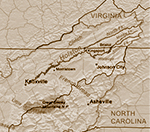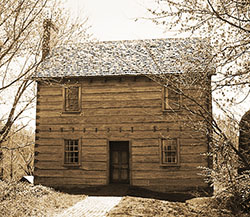 |
||||||||||||||
|
||||||||||||||
Piney Flats, Tennessee |
||||||||||||||
|
Piney Flats is in Sullivan County, Tennessee. The line between Washington and Sullivan Counties is near the village and some residents changed counties without moving. Prior to 1779. the portion of what is now Sullivan County north of the Holston was believed to be in Virginia, and the first grants were issued by that state. The village which is between the forks of the Holston and Watauga Rivers was called The Forks, Shell's Crossing or Shell's Crossroads until the mid-1800's. According to Historic Sullivan, the area of Piney Flats was "infested with packs of vicious and destructive wolves." According to Historic Sullivan in 1767 Joseph Womack built Fort Womack two miles east of Bluff City. It offered protection for the settlers who lived in the area from the Cherokee. Daniel Boone blazed his trail through what is now Austin Springs Road in 1769. See Austin Springs Road on the map of the Piney Flats area. Henry (Hal) Massengil, Sr. came to the area in 1769 from Virginia and built a log cabin. The History of Sullivan County
The Malone family came before 1777 when John Sr., George, John Jr., and William signed the 1777 Washington County petition asking Virginia to relocate the county seat. Between 1770 and 1772, William and Barsheba (Whitehead) Cobb settled in the area. They brought their family from North Carolina and settled at Rocky Mount (see map). Their children included Penelope Cobb who married Hal Massengill. The Massengills continued to live at Rocky Mount. The Reverend Joseph Rhea came to the Holston settlements from Maryland. He accompanied the Christian expedition of 1776 as chaplain. Reverend Rhea returned to Maryland, but in 1776 he came again with his oldest son, John Rhea, and bought land on Beaver Creek. Henry Massengill wrote that
The original log church was completed by July, 1777. Mathias Little, Valentine Little, George Little, and Andrew Little were granted land in Sullivan County by the state of North Carolina in 1792. They arrived about 1777. The Littles, Patrick Cragun and George Webb all arrived about the same time. Reverend Rhea died before he could come back, but in 1778 a group of his followers including, Elizabeth McIlwaine Rhea, came to Piney Flats. Robert, John and Finley Alison and John Scott were members of the Maryland congregation. William and Mary McKinley from Maryland probably came at this time, but did not buy land until 1785. The Reverend Francis Hodge and his wife, Martha (Sally) Sproat came from Ireland by way of Pennsylvania and Maryland and built a log cabin at the head of Sugar Hollow near Pickens Bridge (see map) in 1778. Henry Massengill wrote that in
The New Bethel Presbyterian Church was organized in 1782 by Reverend Samuel Doak (1749). In 1782, Arnold Shell (Schell) and Edward and Elizabeth King were granted land in what would become Piney Flats. John Nicholas and Margaretha Mottern migrated from Berks County, Pennsylvania to Sullivan County in the late 1780's. Mottern Cemetery is on the map. George Milhorn (1783-1872) came from Virginia and bought land in 1788. George (Johan Jorg) Emmert came with his famly to the Piney Flats area from Pennsylvania.
In 1790 William Blount a land speculator and statesman, made Rocky Mount, the home of William Cobb, the first capital of the Southwest Territory (what is now Tennessee), but eventually moved it to Knoxville because of Indian problems. September 14, 1795 Michael and Mary Waggoner purchased 200 acres south of the Holston River in Sullivan County from John Anglin, for 120£ Virginia Currency. Elijah Cross received a land grand in Sullivan County in 1794 and in 1796 as did Moses Looney. (Tennessee Land Grants, Volume I by Barbara, Byron and Samuel Sistler 1998.) Joseph Cole was in Sullivan County by 1794 when he was mentioned Elijah Cross's deed for land on Beaver Creek Lewis and Barbara Rinehart moved from Pennsylvania to Eastern Tennesseen after the American Revolution. They had two sons, George and Lewis, and five daughters including Susannah Rinehart, Barbary Rinehart Gross and Sarah Rinehart. Henry and Mary Smith settled on Evans' Branch on the south side of the Holston River by 1798. John Alison bought land in 1798 and moved to Sullivan County in 1804. He built a log house which was across the road from Gertie and Carlie Alison's brick house. Harmon Arrants and his wife, Francina Price, came from Maryland. About 1800 Gabriel and Henry Devault moved to Piney Flats.
|
|
||||||||||||
| Undated juries of men appointed to lay out roads from Historic Sullivan: | ||||||||||||||
|
|
|||||||||||||
|
|
|
||||||||||||
|
||||||||||||||
|
||||||||||||||
1809 Petition of William Sitzler regarding Sullivan County land 18 grant. Named in petition: Frederick Emert, John Hall, Benjamin Sharp, Abraham McClellan, William Hicks, & John Cox. |
||||||||||||||
In the mid-1800's the Reverend Andrew Shell (1797-1880) applied for a post office at "Piney Flats." Andrew was a pioneer Methodist preacher in eastern Tennessee, and founded a church on his land was called Shell's Chapel. It is known as the Piney Flats Methodist Church. . .The Shell cemetery is located at this church." The Gross homeplace was built by Joseph (Jacob) Gross in 1852. Later, John Gross' store was a post station and country store, as well as, the mustering site for local military units during the Civil War. "Judge" Liburn Cartwright, operated the store for a long periods. |
||||||||||||||
The railroad depot was built in 1858. The Union Church of Piney Flats was established in 1873. It housed the worship of four different denominations; Methodist Episcopal, Methodist Episcopal Church South (until the 1930's), Baptist (until the 1950's), and Presbyterians. |
||||||||||||||
|
Akard Lane View Piney Flats in a larger map
|
||||||||||||||
|
||||||||||||||
|
©Roberta Tuller 2020
|
||||||||||||||



